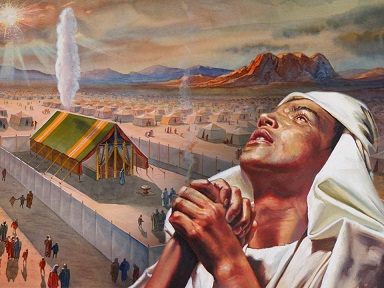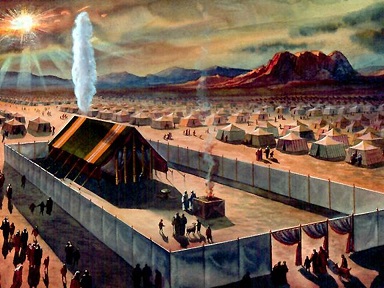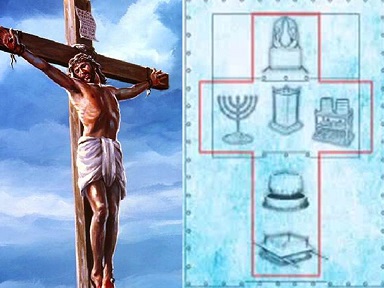
The Feasts of the Sanctuary

Samuel Smith
23 Jan'19
5
LESSON 4
THE FEASTS OF THE SANCTUARY
You are welcome to another edition of Insights from God's Word, a Bible study programme that is committed to sharing God's Word by allowing the Bible to speak for itself.In this edition, we continue with our series on His Way is in the Sanctuary. The topic for this study is: The Feasts of the Sanctuary. In our previous study, we considered the two broad services of the Israelite Sanctuary. However, besides the daily and yearly services that were related to the atonement of various sins, there were also other feast days or festivals that were celebrated each year. The Lord gave specific instructions concerning the various feasts that were to take place in the sanctuary. In this study, I want us to focus on:
i) the various feast days that were connected with the Israelite sanctuary service and
ii) how these feast days were perfect symbols that pointed forward to the life and work of the coming Redeemer.
Friends, the feast days or festivals were grouped into two broad categories. There were Spring Festivals as well as Autumn Festivals. The Spring festivals included Passover, Unleavened Bread, Firstfruits and Pentecost. The Autumn festivals were made up of Trumpets, Atonement and Tabernacles. At this point, we will take our time to examine the various festivals one after the other and determine how each of them pointed forward to the work of the Great Antitype, Jesus Christ.
A) SPRING FESTIVALS
1) PASSOVERKey Texts:
Period: 14th Day of 1st Month (Nisan)
Representation: From the key texts above, the following points can be made in relation to the Passover lamb:
i) On the 10th day of the first month (Nisan 10), each household was to choose for themselves a lamb (
ii) The lamb which was chosen was to be without blemish (
iii) The lamb was to be kept in the house until the 14th day of the first month (Nisan 14). In the evening of Nisan 14, the whole congregation of Israel was to kill the lamb (
iv) After the lamb was killed, each household was to take the blood and strike it on the two doorposts and the lintel of their house (
v) Each household was then to eat the Passover lamb with unleavened bread and bitter herbs during that same night (
vi) In the preparation of the lamb and its consumption, not a single bone was to be broken (
This feast was first celebrated by the people of Israel in the land of Egypt. As the destroying angel passed through the land of Egypt to destroy all the firstborns of the Egyptians, the blood on the doorposts and lintel of the people of Israel was to be a sign to the destroying angel that they were the people of God. All those who heeded the command of God and placed the blood of the Passover lamb on their doors and lintel were saved (see
It is interesting to note that all the ordinances that accompanied the Passover feast were fulfilled in the perfect life and death of Jesus Christ. Here are some of the clear parallels:
i) SELECTED TO DIE ON NISAN 10
On the 10th day of the first month (Nisan 10), the religious leaders of Israel met and decided to condemn Jesus to death. From the beloved apostle we read the account of what exactly happened:
11:48 If we let him thus alone, all men will believe on him: and the Romans shall come and take away both our place and nation.
11:49 And one of them, named Caiaphas, being the high priest that same year, said unto them, Ye know nothing at all,
11:50 Nor consider that it is expedient for us, that one man should die for the people, and that the whole nation perish not.
11:51 And this spake he not of himself: but being high priest that year, he prophesied that Jesus should die for that nation;
11:52 And not for that nation only, but that also he should gather together in one the children of God that were scattered abroad.
11:53 Then from that day forth they took counsel together for to put him to death."
(
ii) CRUCIFIED AND DIED ON NISAN 14
The Passover lamb was brought out four days after its selection and killed in the evening. In the same way, Christ was condemned in the minds of the religious leaders on Nisan 10 and brought out to be killed on Nisan 14. Christ died on the exact date and time that the Passover lamb was killed. From
15:35 And some of them that stood by, when they heard it, said, Behold, he calleth Elias.
15:36 And one ran and filled a spunge full of vinegar, and put it on a reed, and gave him to drink, saying, Let alone; let us see whether Elias will come to take him down.
15:37 And Jesus cried with a loud voice, and gave up the ghost."
(
iii) NONE OF HIS BONES WAS BROKEN
None of the bones of the Passover lamb was to be broken. We find this symbolism perfectly fulfilled in the death of Christ. From
19:32 Then came the soldiers, and brake the legs of the first, and of the other which was crucified with him.
19:33 But when they came to Jesus, and saw that he was dead already, they brake not his legs:"
(
iv) HE WAS A LAMB WITHOUT BLEMISH
Just as the Passover lamb was to be without blemish (
1:19 BUT WITH THE PRECIOUS BLOOD OF CHRIST, AS OF A LAMB WITHOUT BLEMISH AND WITHOUT SPOT:
1:20 Who verily was foreordained before the foundation of the world, but was manifest in these last times for you,"
(
2) UNLEAVENED BREAD
Key Texts:
Period: 15th to the 21st Day of the 1st Month (Nisan). This festival was a weeklong festival.
Representation: Just as Christ fulfilled the Passover feast in His own death on the cross, so did He fulfill the ordinances of the feast of unleavened bread. The Israelites were to eat the Passover lamb with unleavened bread and bitter herbs. Before His death, Christ said the following in relation to the unleavened bread at His last supper with the disciples: "And he took bread, and gave thanks, and brake it, and gave unto them, saying, THIS IS MY BODY WHICH IS GIVEN FOR YOU" (
According to Jewish tradition, the unleavened bread was to be marked with stripes and pierced through with holes in the process of cooking. This ordinance is also clearly seen in the sacrificial death of Christ for mankind. In His trial, Christ endured several stripes on His body from Roman soldiers (see
Friends, the festival of unleavened bread was a symbol of the perfect sacrifice of Christ. Christ is the True Bread which came down from heaven (
3) FIRSTFRUITS
Key Text:
Period: Within the weeklong festival of Unleavened Bread is the Feast of Firstfruits which is celebrated in connection with Barley Harvest. This festival took place on the 2nd Day of the Feast of Unleavened Bread. This period is actually the 16th Day of the 1st Month (Nisan). During this festival, the Israelites will bring a sheaf of the firstfruits of their harvest unto the priest. The priest will wave the sheaf before the Lord to be accepted on behalf of the people. After the firstfruits is accepted by the Lord, the people could now go and gather the bulk of the remaining harvest.
Representation: Christ fulfilled the festival of firstfruits through His resurrection from the grave. The apostle Paul did not mince words when he wrote the following concerning the fulfilment of this feast: "But now is Christ risen from the dead, and become the firstfruits of them that slept" (
Beloved, it is interesting to note that just as the people of Israel brought the wave sheaf offering to the tabernacle to be presented to the Lord for acceptance through the priest, so did Christ also present Himself to the Father immediately after His resurrection to hear the assuring words that His sacrifice on behalf of mankind has been accepted (compare
4) PENTECOST
Key Text:
Period: 6th day of 3rd Month (Sivan). This period is obtained by counting 50 days from the feast of firstfruits (that is, the 16th Day of the 1st Month, Nisan). Pentecost means 'fiftieth' or 'fifty days', and the symbolism is derived from the fact that Moses received the Ten Commandments on Mount Sinai 50 days after the Israelites left Egypt on the night of the Passover (see
Representation: Christ fulfilled the festival of Pentecost by honouring the promise He made to the disciples in relation to the outpouring of the Holy Spirit. Just as the feast of Pentecost came exactly 50 days from the feast of firstfruits, so was the Holy Spirit also poured out on the apostles exactly fifty days after the resurrection of Christ (see
B) AUTUMN FESTIVALS
1) TRUMPETSKey Text:
Period: 1st Day of 7th Month (Tishri). On this day, the priests of the Lord blew the trumpets to warn the people of the coming Day of Atonement. This feast came 10 days before the Day of Atonement.
Representation: This festival was fulfilled through the events of the Great Advent Awakening which took place in various parts of the world approximately 10 years before 1844. People such as William Miller and others across the world were inspired by the Spirit of Christ to preach the uncommon message that the hour of God's judgement was near (see
2) DAY OF ATONEMENT
Key Text:
Period: 10th Day of 7th Month (Tishri). On this day, the high priest entered the Most Holy Place of the tabernacle to atone for the sins of the entire nation of Israel. On this day, the numerous sins of the penitent that have been transferred into the sanctuary were cleansed. The Day of Atonement was also the great day of judgement for the people of God. The Scripture makes it clear that anyone who held on to any sin during the period was cut off soon after the work of the high priest was over. It is important to note that this feast is the same as the yearly service ministration of the sanctuary.
Representation: Christ fulfilled this festival when He entered into the Most Holy Place of the sanctuary in heaven to begin the work of judgement. This anti - typical Day of Atonement began in the year 1844, at the end of the 2,300 days prophecy of
3) TABERNACLES
Key Text:
Period: 15th to the 22nd Day of the 7th Month (Tishri). This festival is actually an eight day festival. During this period, the Israelites stayed in tents in remembrance of their Exodus from Egypt to the land of Canaan. The festival coincided with the fruit harvest and was also known as the feast of Ingathering.
Representation: This festival points forward to the final ingathering of God's children into the kingdom of heaven (see
Beloved, at this point in history, God expects His children to look beyond the earthly sanctuary ordinances, and behold by faith the work of Christ in the Most Holy Place of heaven's sanctuary. And just as the Israelites afflicted their souls in anticipation of the return of the high priest from the earthly sanctuary, so does the Lord require from us to also afflict our souls and make our hearts right with Him, even as we await the end of Christ's work in the Most Holy Place, and His triumphant return to redeem His saints from this sin - infected planet.
Exhortation: Even though the religious leaders of Israel were looking forward to the coming of the Messiah, they had ignored Jesus and the clear power that attended His work. Instead of accepting Him as the long promised Messiah, they rather immersed themselves in outward religious ceremonies. In clear poignant words, Christ rebuked them: "Search the scriptures; for in them ye think ye have eternal life: and they are they which testify of me" (
Dear friend, are you also caught up in various ceremonies that accompany the worship of God to the extent that you have forgotten to develop a living relationship with the Saviour? If this is your situation, you need not despair as there is still hope. The Saviour's invitation to each one is this: "And the Spirit and the bride say, Come. And let him that heareth say, Come. And let him that is athirst come. And whosoever will, let him take the water of life freely" (
In our next study, we will consider the topic: His Way is in the Sanctuary. The Bible study references for this study are
Stay blessed and keep shining for King Jesus.
Maranatha!
Powered by White Throne Ministries











